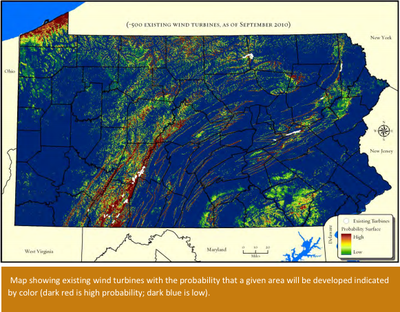Foundational Research
 Previous studies that assessed future energy development potential and were part of The Nature Conservancy's Development by Design approach include:
Previous studies that assessed future energy development potential and were part of The Nature Conservancy's Development by Design approach include:
Pennsylvania Energy Impacts Assessment: Marcellus Shale Natural Gas and Wind Energy
The Pennsylvania Energy Impacts Assessment sought to answer:
- How much of each energy type might be developed?
- What transmission infrastructure will be needed to get more electric power and natural gas to consumers?
- Where are these energy types most likely to be developed?
- How does the likely scale and location of future energy development overlap with priority conservation areas?
By answering these questions, conservationists can work more effectively with energy companies and government agencies to avoid, minimize, or offset habitat impacts in the future. This research developed credible energy development projections and assessed how they might affect high priority conservation areas across Pennsylvania. Marcellus natural gas, wind, wood biomass, and associated electric and gas transmission lines were chosen as the focus since these energy types have the most potential to cause land-use change in the state over the next two decades. The conservation impacts focus is on forest, freshwater, and rare species habitats.
Shale Gas, Wind and Water: Assessing the Potential Cumulative Impacts of Energy Development on Ecosystem Services within the Marcellus Play
Global demand for energy has increased by more than 50 percent in the last half-century, and a similar increase is projected by 2030. This demand will increasingly be met with alternative and unconventional energy sources. Development of these resources causes disturbances that strongly impact terrestrial and freshwater ecosystems. The Marcellus Shale gas play covers more than 160,934 km2 in an area that provides drinking water for over 22 million people in several of the largest metropolitan areas in the United States (e.g. New York City, Washington DC, Philadelphia & Pittsburgh). In this study, probability surfaces representing development potential of wind and shale gas for portions of six states in the Central Appalachians were created. Researchers used these predictions and published projections to model future energy build-out scenarios to quantify future potential impacts on surface drinking water.























